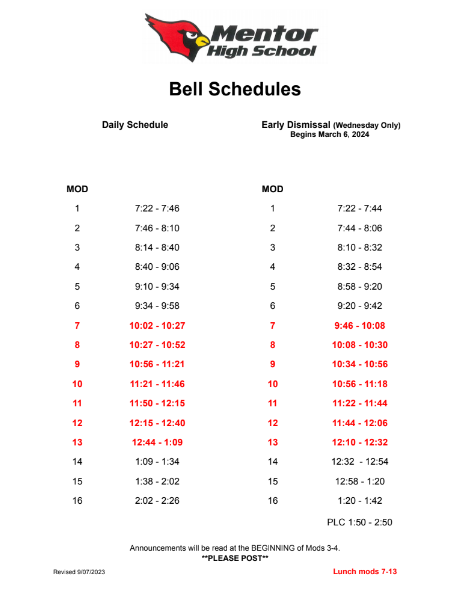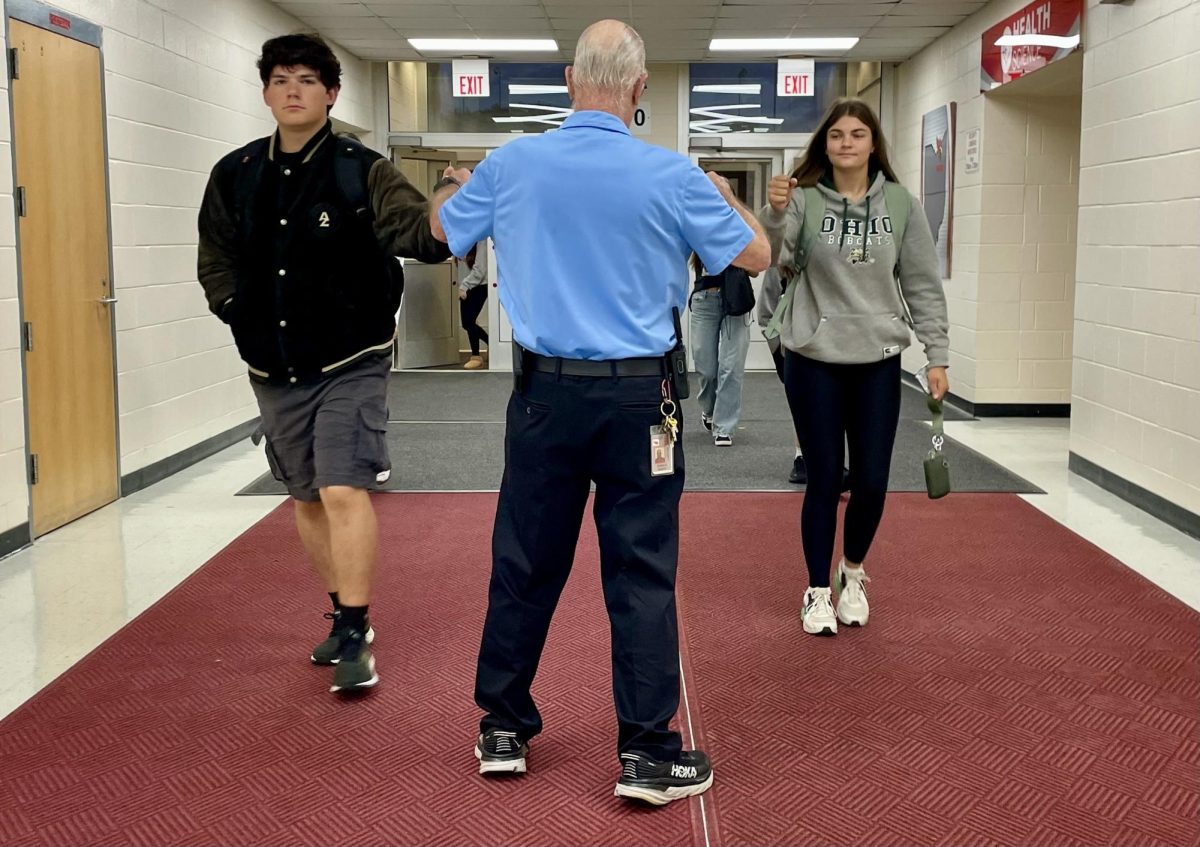On Wednesday, October 1st, Principal John Fullerman announced that Mentor High School will be returning to a standard bell schedule on Wednesdays starting October 15th. This change comes just seven weeks into the 2025-2026 school year, marking another mid-year switch for students and teachers. The last time a change to the bell schedule was made was in 2024, when former Principal Jason Crowe and Mentor High School administration implemented the early dismissal policy, changing from the late start Wednesdays that had become tradition at Mentor High School.
Precedent

On March 6th, 2024, MHS switched to the early-dismissal bell schedule, which it has operated under ever since, giving students a shorter day on Wednesdays and allowing teachers essential planning time for their classes. While still a significant change, it was mitigated by the fact that late-start Wednesdays had been in place up until that point, offering the same benefits to teachers and students, just at a different time of day. In 2024, when questioned about the reasoning behind the switch to early dismissal, then-Principal Jason Crowe cited the need to “address the increase of tardies and behavioral infractions” during late-start schedules.
The policy ran largely without interruption during the 2024-2025 school year and into this school year. However, with the abrupt change, students and teachers alike will lose the time they have come to value during past years in exchange for longer class periods.
Immediate Reaction

Before the announcement, rumors began spreading around the high school that the change was imminent, but many failed to believe its truth. For some, the change seemed a shocking shift in school policy, which has often favored the student experience. Items such as Senior Painted Parking Spots and leisurely seating around the building have catered to the social experience of high school students, but the change now reflects a shift in focus toward educational endurance. With confirmed changes, student reactions have already begun pouring in.
One Sophomore, Metodija Stojkoski, mentioned the benefit of having extra time to catch up on school work: “Without this time, it becomes much harder to balance schoolwork with personal responsibilities, which can lead to increased stress and lower overall school performance.” While Stojkoski’s claims are speculative, his concerns indeed represent a larger student opinion against the switch.
A Senior and Cardinal Nation editor, Juliana Nichols, offered that MHS Seniors have experienced a similar change from late start to early dismissal. She noted that Freshmen protests to the change seem “ridiculous” as they have only experienced the early dismissal for a very short period of time. However, Nichols mentioned that the change would negatively affect many students, especially seniors, “with their already rigorous schedules and trying to apply to college at the same time.” She further noted, “This is not one of the issues that the district needs to focus on.”
For educators, many are simply waiting to see the effects of change, which impacts their planning time.
Explaining the Switch
In an email to the Mentor Schools District, Principal John Fullerman explained that regular routines and extended class times will serve to benefit student learning and development. However, the email failed to mention any problems with the previous Wednesday’s bell schedules, only offering a “more consistent schedule” and “the most learning time possible.” To figure out the true reasons for the abrupt change, Cardinal Nation editors Nathan Colagross and Nicholas Payne met with administrators John Fullerman and Ryan McKnight, seeking answers in the uncertain time.

We wanted to explore more what was meant by a “more consistent schedule,” since our week-to-week schedule was already consistent, questioning the administration about the specific problems they are attempting to fix.
Fullerman emphasized that the administration believed a schedule that was consistent day to day would be more effective than a schedule that is consistent week to week. Having a consistent five-day schedule is seen as a solution to the behavioral problems and tardiness that are seen on Wednesdays. Fullerman notes that tardies and behavioral incidents spiked on Wednesdays. It was unclear what school disruptions had increased frequencies on Wednesdays. When asked to clarify what school disruptions are, Fullerman said they are a wide range of events that “disrupted the school day.”
We asked for more specific data for clarification. Fullerman responded that “when we look at our data, we see our tardies peak [mods] 3-4 Wednesdays.” We asked for some quantitative information. Off-hand, Fullerman recalled that Wednesdays had 17 more behavioral disruptions than Mondays, 15 more than Tuesdays, and 12 more than Thursdays. When looking at the chart of reported incidents, Fullerman saw a spike on Wednesdays. However, it is important to consider the relative increase in behavior incidents on Wednesdays to truly see if there is a substantial difference. We asked for the total number of incidents on each day, but Fullerman was unable to provide that data at the time.
Following our meeting, we reached out to Fullerman, offering the chance for him to provide the statistics, where he noted that behavior referrals peaked on Wednesdays during September, referencing a 50% increase from normal school days. Moreover, Fullerman noted a 24% increase during the first week of October compared to standard Monday, Tuesday, and Thursday schedules.

Early dismissal on Wednesdays provided teachers with valuable time for Professional Learning Communities (PLC). During these meetings, teachers collaborate to create the most effective lessons to increase student learning opportunities. To see how this change would affect educators, we asked the administration.
Fullerman noted that teachers were to be provided time through different venues in order to provide teachers with “similar time, not the same time” for PLC meetings. When asked to clarify, Fullerman added that there may be more or less time for PLC depending on the month. October was highlighted as a month with the greatest amount of PLC time. Ryan McKnight briefly spoke on Fullerman’s comment of “similar time, not the same time,” saying it could be the difference between “two hours and two and a half hours.”
Fullerman noted that plans are being developed to make up for lost PLC time by allowing more delegated time for PLC during meetings and during half or quarter days. When asked if this meant there would be more days in which this opportunity was present, Fullerman noted he would be focused on creating more time during existing meetings. It was also noted that the faculty council and department coordinators would be working to balance PLC time moving forward.
We also wanted to know what input was gathered before making the decision, especially from students.
No student feedback was gathered before the decision was made. When asked why, Fullerman said the decision would be discussed later in a future Principal Advisory meeting, mentioning he was a “big fan” of gathering student opinion.
We then asked Fullerman if the possibility remained to return to early dismissal or a similar schedule.

Fullerman said that there should be data by December showing improvements, and if there are no notable benefits, the administration would be open to future conversations, but maintained that “unstructured time,” when students are allowed to roam freely on school grounds, was not favored at all and would like to be avoided.
In a follow-up response to us, Fullerman also noted a decrease in referrals “when comparing this year referral data to last years at the same point of time in the school year.”
Overall, Fullerman and McKnight viewed the change “not as reactive, but responsive.” They maintained that such changes are always focused on improving student achievement and instructional time.
The Real Effects
In truth, the effects will have to be seen on October 15th, when Mentor High School returns to a standard bell schedule for every day of the week. However, anticipation for the change has already stirred debate in MHS over the effects it will have.
So far, some teachers have expressed concerns that their essential planning time for themselves and collaboration time among teachers will be cut off, forcing instructors to use additional time to set up meetings and plan course lessons. On the other hand, the extra class time will allow additional material to be covered in class, allowing teachers to better keep a consistent daily pace.

For students, extended class times will mean that additional material can be covered, lessening the load placed on homework and outside learning. However, the change also means that the coveted shortened periods will be eliminated. No longer will students be able to wake up later or leave school earlier; instead, they will be subject to a five-day work week without the mid-week break. Students will also not have access to the extra time often used for homework or studying.
For families, the change will significantly alter travel plans and after-school traditions. Students normally picked up during the early dismissal schedule will now either be placed on a bus home or will be picked up at different times, forcing parents and guardians to alter their schedules, if needed, to cater to the changing bell schedule.
While the change has both its pros and cons for all involved, only time will tell whether the policy change is effective or not.














